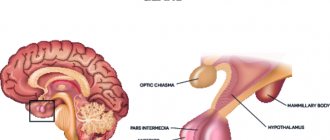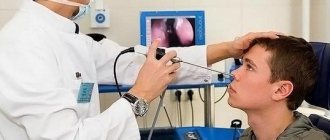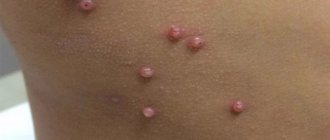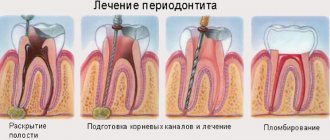| Congenital iodine deficiency syndrome | |
| ICD-10 | 00. |
| ICD-9 | 243243 |
| DiseasesDB | 6612 |
| eMedicine | ped/501 |
| MeSH | D003409 |
Cretinism
(from the French crétin - idiot, weak-minded) is an endocrine disease caused by a lack of thyroid hormones, characterized by a pronounced decrease in thyroid function, delayed physical and mental development. One of the forms of congenital hypothyroidism. The term “cretin” is outdated and is not recommended for use, since it has gone beyond a purely medical framework and began to have a social (negative) connotation. Nevertheless, traditional terms continue to be used in psychiatric literature today.
Clinical manifestations
Characteristic signs of cretinism:
- retardation of physical development,
- delayed growth and change of teeth, prolonged non-fusion of the fontanelles of the skull,
- coarse facial features (due to swelling of the soft tissues): a wide flat (“square”) nose with a sunken back, eyes far apart from each other (ocular hypertelorism),
- large tongue (often it does not fit in the mouth),
- disproportionate body structure: short limbs, large head,
- thick and rough skin,
- underdeveloped secondary sexual characteristics,
- disorders of mental and mental development (up to idiocy),
- short stature (often dwarfism)[3].
In severe cases, myxedematous edema (myxedematous cretinism) is observed.
Cretinism in adults
Hypothyroidism leads to cretinism in adults, which is called myxedema in the medical literature. There is also secondary myxedema, which is a consequence of damage to the pituitary gland and hypothalamus. These are endocrine glands located in the human brain. The more severe the physical defects, the more severe the mental ones. Endemic cretinism is not characterized by this feature.
Adults with cretinism do not show initiative, they are stupid, indifferent and do everything slowly. They do not show friendly emotions towards others, trust few people, and are prone to grumpiness. Cretins are characterized by easy suggestibility and emotional instability, they love affection. When they become angry, they pose a threat to others. Affective outbursts with cretinism in adults are rare and do not last long. The best way to calm a cretin down is with affection.
Often with this diagnosis, people are depressed and can commit violence against themselves. In medical practice, there have been cases of the development of schizophrenia and psychosis in people diagnosed with cretinism. As a child grows up, he ages faster than his healthy peers. The body of people with this pathology requires an increased amount of heat, which is why they like to stay in bed for a very long time. With myxedema, the patient often experiences weight gain and obesity.
Features of cretinism in adults:
- loss of previously existing skills and abilities
- decreased activity
- gets tired too quickly
- constant chilliness and periodic desire to increase your activity (which can lead to drug addiction and alcoholism)
- interests are often limited to basic human needs
- if with cretinism a person is able to do something simple, then he does it slowly, “under pressure”
- Adult cretinism does not always have a goiter
- myxedema is more often noted in mild form than in severe form
- anemia
- possible eczema
- there may be constipation
- menstruation disorders
- joint pathologies
- Possibly decreased gastric acidity
- there may be no physical abnormalities, but mental abnormalities are mild
In endemic regions (which are characterized by the birth of children with cretinism), healthy people may also experience mildly expressed some features of the disease. People in such areas are mentally limited, slow and lethargic.
Treatment
| This section is not completed. You will help the project by correcting and expanding it. |
In the early stages, cretinism is fully compensated by taking thyroid medications (thyroxine).
Screening of newborn children plays a major role in the early detection of the disease; in particular, in Russia, screening is carried out for all children born on the fourth day of life (full-term) and on the seventh day (premature). The screening system determines the level of thyroid-stimulating hormone in the blood; this indicator gives an idea of the function of the thyroid gland and is key in making a diagnosis. If an elevated level of thyroid-stimulating hormone is detected, the child is immediately retested and preventive treatment with thyroxine is prescribed.
It is important to initiate treatment as early as possible to avoid the adverse effects of thyroid hormone deficiency. Children who start treatment before the 21st day of life do not lag behind healthy peers in development. In advanced cases, when screening was not carried out (home birth, early discharge from the maternity hospital) and treatment was not prescribed on time, children are developmentally delayed, have speech and intelligence delays. Characteristic signs of congenital hypothyroidism are: dry skin, constipation, poor weight gain, lethargy of the child.
Diagnostics
At the birth of a child, cretinism is diagnosed based on characteristic symptoms. In other clinical situations, an endocrinologist is involved in diagnosing pathology. To make an accurate diagnosis, you must undergo the following examinations:
- radiography;
- if a child is suspected of having an illness, it is necessary to conduct a test to determine congenital defects and metabolic disorders on the 3rd day of his life;
- blood analysis;
- Ultrasound of the thyroid gland;
- blood test to determine the level of thyroid hormones;
- The relationship between the thyroid gland and globulin is assessed.
Prevention
| This section is missing references to information sources. Information must be verifiable, otherwise it may be questioned and deleted. You may edit this article to include links to authoritative sources. This mark was set on February 9, 2020 . |
In geographic regions with a low iodine content in the environment (water, air and soil) - the so-called iodine endemic - mass (using the method of universal salt iodization) or individual (taking iodine and selenium tablets) prevention is carried out among the population.
Your dermatologist
Great Medical Encyclopedia Authors: M.K. Klimova, D.D. Orlovskaya, A.M. Raskin.Cretinism is a syndrome characterized by irreversible disorders of nervous, mental and somatic development associated with a deficiency of thyroid hormones at a critical stage of brain development.
Etymology of the term: French - cretinisme.
The term “cretin” was proposed in the 17th century by Ph. Platter in the works of 1614. T. B. Curling in 1850 and Ch. H. Fagge introduced the concept of “sporadic cretinism” in 1871. Later, a connection between cretinism and hypothyroidism was established.
There are endemic and sporadic cretinism.
Etiology and pathogenesis
The main etiological factors of endemic cretinism are the same as those of endemic goiter. Iodine deficiency or the presence of goitrogenic substances in food. The role of genetic or other factors cannot be ruled out. This is indicated by the fact that cretinism in goiter-endemic areas occurs mainly in families where there are marriages between blood relatives.
In areas where goiter is endemic, according to O. Bleha in 1966 studies, cretinism is observed in 1-4% of the population. Thanks to iodine prophylaxis and improved hygienic conditions, the incidence of endemic cretinism has decreased significantly and cretinism is rare in economically developed countries.
In the etiology of sporadic cretinism, hereditary defects in enzyme systems that ensure the synthesis and exchange of thyroid hormones are important. These include defects in iodination, iodine organification, impaired synthesis of iodothyronines from iodotyrosines, deiodination, leading to the development of sporadic nontoxic goiter and hypothyroidism. In 60-70% of patients with sporadic cretinism, hypothyroidism is associated with disorders of the embryonic development of the thyroid gland - athyroidism, hypoplasia, and ectopia.
The cause of sporadic cretinism can also be treatment of the mother during pregnancy with thyreostatic drugs or radioactive iodine. Deficiency of thyroid hormones in utero (in the third trimester of pregnancy) and in the early postnatal periods, when brain development is in a critical phase, leads to a delay in the somatic and mental development of the child, congenital hypothyroidism. If a deficiency of thyroid hormones is detected in a child at an older age, then all manifestations of cretinism are less pronounced.
Pathological anatomy
With endemic cretinism, both atrophy of the thyroid gland and diffuse or nodular goiter are detected. Microscopic examination of the thyroid gland during its atrophy reveals individual small follicles and clusters of cells against the background of sclerosis. Goiter nodes are often single, they show fibrosis, cystic transformations, and calcification.
With sporadic cretinism, the absence of the thyroid gland or dystopia of its rudimentary formations at the root of the tongue or in the soft tissues of the neck is often detected.
If hypothyroidism was associated with defects in hormone synthesis, nodular or diffuse goiter is observed, sometimes reaching large sizes. The adenohypophysis is hypertrophied due to an increase in the number of γ-cells. The gonads are atrophically changed. Internal organs are reduced in size. By the time skeletal growth stops, varying degrees of dwarfism are observed. Bone changes are symptomatic: the skull is deformed, its base is underdeveloped in comparison with the arch. There is a predominant thickening of the frontal and parietal bones, deep-set nasal bones, a protruding lower jaw and other bone changes consistent with those in congenital hypothyroidism in children.
Clinical manifestations
The defining symptoms are a sharp delay in physical and mental development and neurological disorders. The first symptoms of cretinism can be detected in the first months of life and are combined with signs of hypothyroidism. More often, cretinism becomes obvious only by 4-6 years of age.
MP Konig in 1968 distinguished two clinical forms of cretinism:
- nervous,
- myxedema.
The nervous form is characterized by:
- hearing and speech impairment up to deaf-muteness,
- decrease in intelligence up to idiocy,
- neuromuscular disorders – spastic-hypokinetic or hypotonic-hyperkinetic manifestations,
- disorders of the pyramidal system,
- ataxia, etc.
Signs of hypothyroidism in this form of cretinism are mild.
In the myxedematous form, signs of cretinism are detected against the background of the clinical picture of hypothyroidism.
The appearance of cretins is characteristic: short stature up to dwarfism, disproportionate physique with short limbs. A dull expression on a wide, round face with a flat, wide nose, the mouth is often slightly open, the tongue is enlarged, and the neck is short. Some patients have a goiter, and the abdomen is protruded. The muscles are poorly developed, movements are clumsy and slow, and there is a waddling gait. Tendon reflexes are slow. Changes in the skin and internal organs characteristic of hypothyroidism in children are observed. Delayed sexual development and underdevelopment of the genital organs are common. All these phenomena are especially pronounced in severe forms of cretinism.
Characteristic disorders of skeletal development revealed by X-ray examination. These include dysgenesis of the epiphyses in the form of the so-called “striated fragmented epiphyses,” as well as a significant slowdown in skeletal maturation, insufficient development of the base of the skull, and often widening of the sella turcica. A sharp delay in ossification is especially pronounced in childhood and the prepubertal period. The ossification points that appear late slowly increase in size, the metaepiphyseal growth zones remain open for a long time, and synostosis occurs late.
Gradually and slowly, the bone structure of the epiphyses is restored, but their shape remains irregular. With age, the multinucleation of the epiphyses disappears and they acquire uniform density. The deformation of the epiphyses is most pronounced in the proximal parts of the femur and humerus. Long tubular bones are thickened and shortened. The cortical layer is compacted, thickened, the lumen of the bone marrow cavity is narrowed. Other changes consistent with congenital hypothyroidism are also noted.
Mental disorders can be of varying degrees - from mild debility to severe idiocy with a characteristic torpidity of all mental reactions. If hypothyroidism began at 3-4 years of age, severe mental disorders do not occur. But even in the mildest cases, intellectual processes proceed slowly, the ability to retain information and assimilate new things is weakened.
With congenital hypothyroidism, already at 2-3 months, the child’s unusual lethargy, drowsiness, and lack of normal reactions to light and sound are detected; in the future, the vitality and mobility of motor skills and affect inherent in children, as well as the acuity of attention, are absent; Speech development is delayed, articulated word formation is impaired (in severe cases, children make only inarticulate sounds).
The range of information of cretins is limited and in severe cases is narrowed to vague ideas about the most basic needs. Many patients can still learn simple skills, but they are slow in completing the work, often interrupt it, and need stimulation. Torpidity of the psyche is reflected in the emotional sphere. Patients are usually apathetic and indifferent, affective outbursts are rare and quickly exhausted; drowsiness and increased need for warmth are common.
Cretins are closed, secretive and unfriendly, they have difficulty making contact, but if one is established, then they can become frank and, with elements of childishness, talk about themselves in great detail. There is a tendency to paranoid and depressive reactions. Sometimes great irritability appears, but calmness easily comes in response to affection.
There are no psychoses specific to cretinism and they rarely develop; Schizophrenia-like states have been noted. In cases of affect-type disorders, it is not true manic-depressive psychosis that occurs, but mood swings characteristic of endocrine psychosyndrome.
Laboratory data indicate an increase in the level of thyroid-stimulating hormone and a decrease in the concentration of thyroid hormones. Other laboratory values may not be abnormal.
Diagnostics
The diagnosis of cretinism in early childhood is difficult. At this stage, it is possible to identify signs of hypothyroidism. In older children and adults, diagnosis is based on clinical, radiological and laboratory signs.
Differential diagnosis
Differential diagnosis of cretinism is carried out with:
- Down's disease
- with gargoilism,
- chondrodystrophy,
- other diseases manifested by dwarfism.
Treatment
The main method is the use of thyroid hormones.
Forecast
The prognosis for cretinism depends on the age at which treatment is started. AG MacGregor, writing in 1964, noted that defects in brain development can be largely overcome if treatment is started in the first months after birth.
Therapy with thyroid hormones, started at an older age, can only eliminate the symptoms of hypothyroidism, if any, while irreversible disorders of somatic and neuropsychic development cannot be corrected.
The prognosis for life is favorable.
Prevention
The prevention of endemic cretinism is facilitated by a set of measures taken to prevent endemic goiter. Intensive treatment with thyroid hormones during pregnancy can help prevent the birth of children with cretinism in women suffering from nontoxic goiter or hypothyroidism.
Great Medical Encyclopedia 1979
Types of pathology
Doctors note two types of cretinism:
- Sporadic . It develops in the womb. It is often a hereditary disease. The geographic area of residence does not affect the occurrence of the disease. In adults, sporadic cretinism may develop due to damage to the pituitary gland or hypothalamus.
- Endemic . Mental and physical pathologies develop in people living in mountainous areas with iodine deficiency. Endemic cretinism is often combined with deaf-muteness and goiter. There is a high probability of its occurrence due to genetic predisposition.
Topographical cretinism
The inability to navigate in an unfamiliar place is often called spatial dementia or topographic cretinism. This condition is not a disease, but only a psychological feature of the individual.
Article on the topic: Milk thistle - medicinal properties and contraindications, folk recipes
Spatial cretinism can be inherited, but more often it is a consequence of absent-mindedness, poor memory or laziness of a person.
About complications and prognosis
If proper treatment is not carried out in a timely manner, the pathology quickly progresses, irreversible changes are formed, and the functionality of the most important systems of the human body is disrupted.
If treatment is started on time (within the first two weeks after birth), then the development of the pathological condition can be prevented. If the treatment is timely and adequate, then there are no problems in the child’s development, but there are certain deviations in intellectual and physical terms. When starting hormone replacement therapy after the month of the baby's birth, the risk of irreversible mental retardation is high, and other complications often develop.
Causes
What reasons do scientists identify for the manifestation of such a terrible disease? The most important are various metabolic disorders and genetic predisposition. But additionally the following are distinguished:
- Lack of iodine in the diet of a mother who is carrying a child prone to this pathology in the future.
- Lack of enzymes that convert iodine into active form.
- Congenital pathologies with the thyroid gland: hypoplasia, ectopia (location in the wrong place), athyroidism (absence of the thyroid gland).
- Reduction of the gland in size.
- Removal of the thyroid gland.
- Violation of hormone synthesis.
- Thyroiditis is an autoimmune lesion of the thyroid gland.
- Abuse of drugs that suppress the functioning of the gland.
- Incest.









